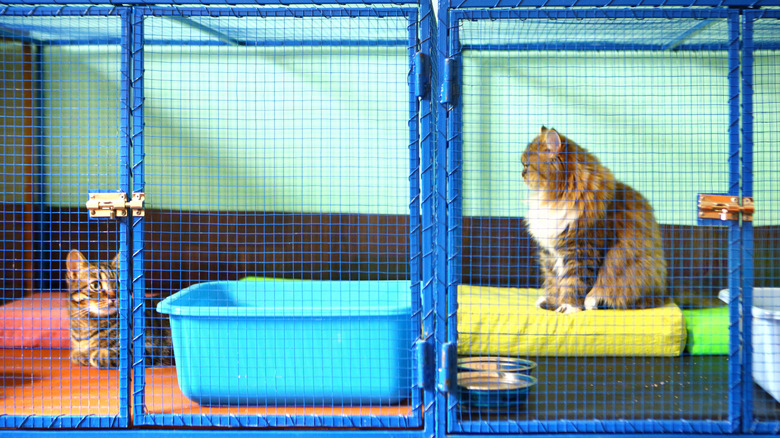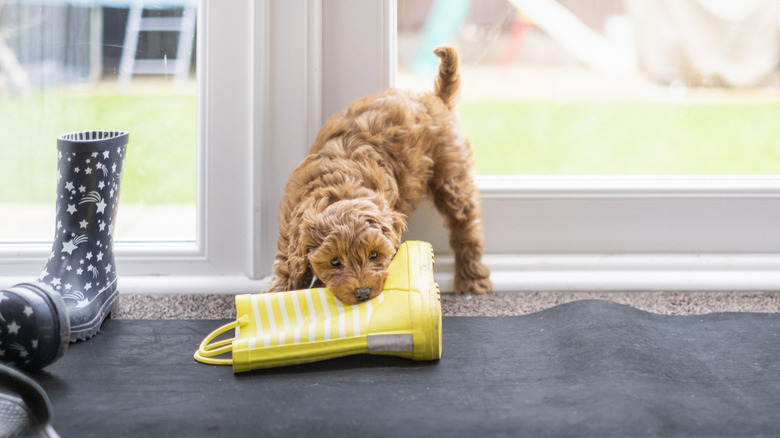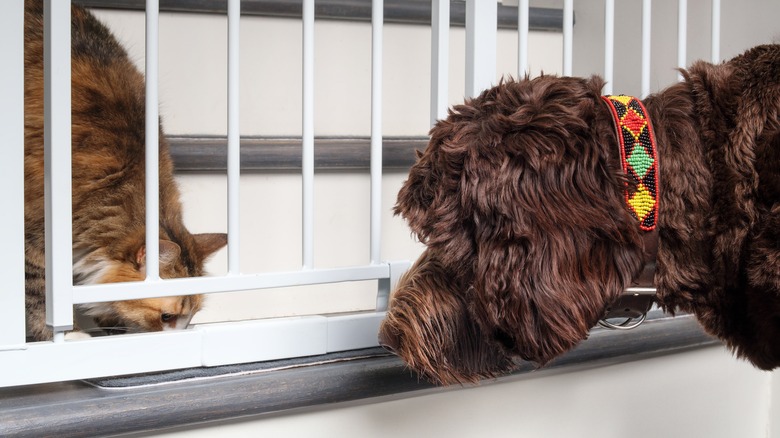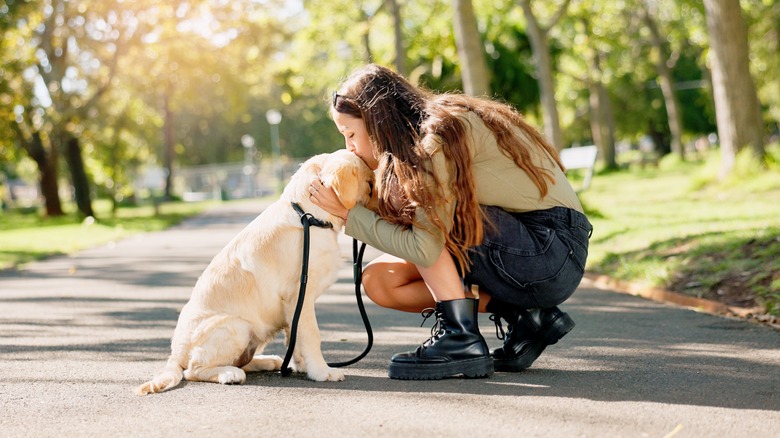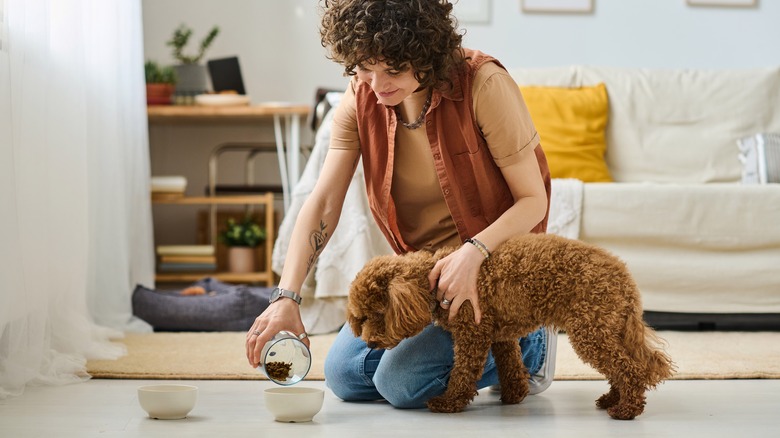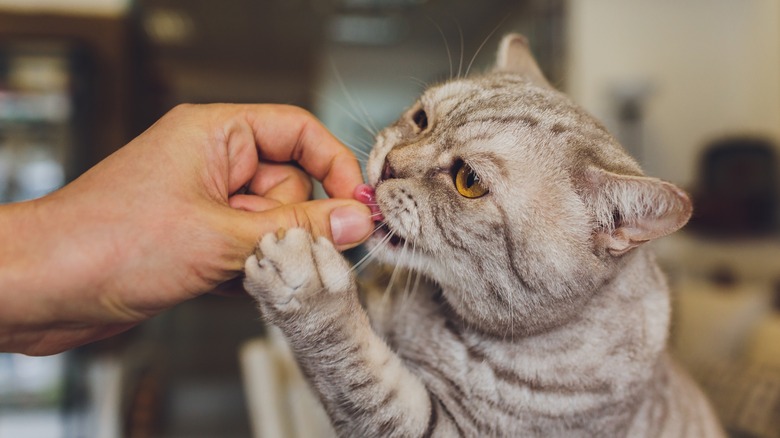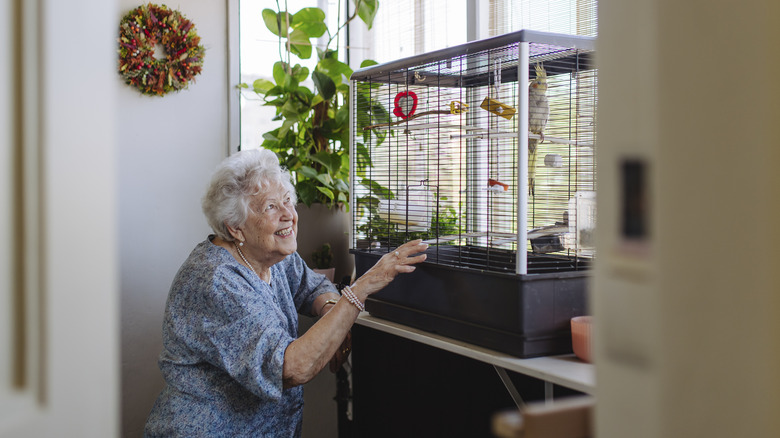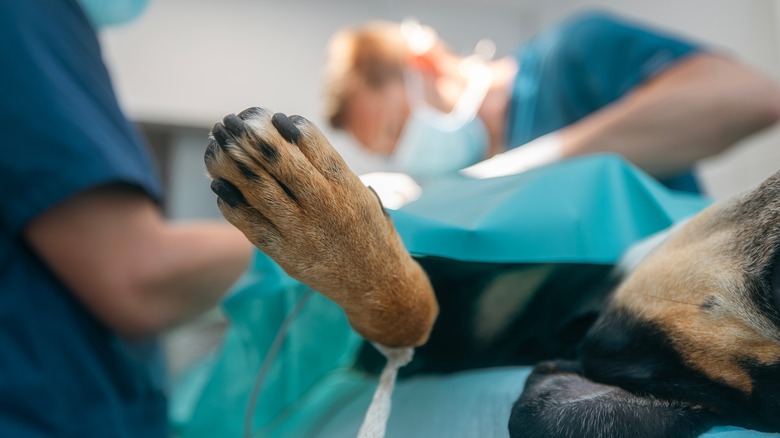14 Mistakes To Avoid When You Adopt A Pet
Once you've decided it's time to welcome a new pet into your home, the best place to start looking is at animal shelters and rescues. According to Shelter Animals Count, about 6.5 million cats and dogs ended up in one of the 14,429 animal-sheltering organizations across America in 2023. Incredibly, 4.8 million of those lives were saved through adoption. However, even with this high figure, around 690,000 lives were ended through euthanization.
As wonderful as it is to adopt, it's important to think long and hard about your decision. Rushing into it, not considering your budget, or underestimating the animal's needs are just some of the mistakes people make that result in pets getting returned to the shelter. Not only is this tough for you, but it's upsetting for the animal.
Adopting a pet means taking on a big responsibility, which can be both rewarding and difficult. You'll have to invest time and energy into their well-being by playing, training, and exercising them, along with slowly introducing your pets to each other so they don't feel threatened or anxious. You could even be taking on a 50-year commitment, depending on the type of animal you take in. However, by avoiding common adoption mistakes, you'll likely be rewarded with cuddles, joy, love, and companionship.
1. Not considering your budget
Per Money, you will spend between $1,500 and $2,000 on your pet in the first year. It isn't free to adopt either, so be prepared for an up front investment of around $150. This fee may vary depending on the type of pet you want and where you adopt from; however, it usually covers spaying or neutering, a health check, initial vaccinations, preventative treatment, and a microchip. When considering the individual costs of these treatments plus the prices of a breeder, adopting a pet is a much more affordable option.
According to the American Society for the Prevention of Cruelty to Animals (ASPCA), even with the lower financial requirements of adoption, you're still looking at a yearly expenditure of around $1,391 for a dog and $1,149 for a cat. This estimate includes your pet's food, snacks, preventative treatments, annual wellness checks, toys, health insurance, grooming essentials, and a few other common expenses. The amount could be higher or lower depending on your lifestyle, whether you need a professional groomer or trainer, and how often you go out of town. Before making the decision to adopt, it's important to look at the stability of your job and ensure your finances can cover your pet's costs.
2. Underestimating how much attention your pet requires
Every pet needs daily attention, but some are much more demanding than others. Adult cats require interaction but generally aren't high maintenance. If you feed them once or twice a day, change their litter box, brush them, and replenish their water bowl, they'll be quite happy. Although cats should never be left completely alone while you're out of town for work, they're a better option for people who have demanding jobs. If you have to go away for a while, make sure someone can check on your cat daily.
Dogs require a lot more attention than most other pets. They need at least one meal a day (age dependent), fresh water, regular brushings, plenty of playtime, and daily exercise. A dog's exercise needs are largely contingent on their breed and age, so it's important to consider these factors when adopting to get the right match for your lifestyle. When looking for a new pet, also consider your work hours and fitness level. For example, border collies need at least two hours of exercise daily. If you're inactive, travel a lot, or work most of the day, you may not be able to meet your pet's needs, which will result in them becoming frustrated and destructive.
3. Overlooking behavioral challenges
It's hard to let go of a pet in a shelter that your heart is set on. But, if the pet you want is known to bite children and you have some at home, they're probably not well-suited for your situation. Likewise, if you live in an apartment and the prospective pet is highly energetic or vocal, you'll end up with complaining neighbors, which may pressure you to move or return the animal. Remember, you have a limited opportunity to gather information about your potential pet by spending time with them in the shelter, so ask the staff questions about their background.
Overlooking unwanted pet behaviors can be dangerous for you and your family, especially if you're not equipped to deal with them. Ignoring these challenges also increases the likelihood that you'll eventually return the pet to the shelter. According to a survey conducted by Scientific Research Publishing (pdf), one of the most common reasons people provided for re-homing their cats and dogs to a shelter was "pet problems," which include problematic behaviors and aggression.
If you have the time, patience, and resources to train a pet with behavioral challenges and are fully aware of what you're committing to, go for it! Every pet deserves a loving home. If you can offer such an environment to a pet without giving up on them, take the opportunity to save their life.
4. Failing to test allergy responses before adoption
If you have a pet allergy, it's crucial to spend time with an animal before bringing them home. You could even chat with the shelter about fostering a cat before adopting one. Whether you're allergic to cats or dogs, being around them will cause some sort of negative response. If you develop severe symptoms, such as blocked nasal passages or trouble sleeping, when near pets, consult your doctor before adopting. However, if your symptoms are mild, living with a pet is possible if you take precautions and are diligent about setting up pet-free zones in your home and washing your hands after touching your pet.
The good news is that, although no pet is fully hypoallergenic, some are less allergenic than others. Per the American Kennel Club (AKC), the Can f 5 protein found in male dogs triggers symptoms in some people. If that applies to you, consider adopting dogs without that protein. Some pets produce fewer allergens due to their size or because they shed less pet dander, so you may find that your symptoms are milder with certain animals. Once you've narrowed down your choices to the pet you want to adopt, spend a few days visiting them. Ask the shelter if you can groom, walk, and play with them to help determine whether you'll be able to tolerate your symptoms.
5. Only considering young pets for adoption
Puppies and kittens are cute, but an older pet could be a more suitable choice for first-time owners and families with young children. First, taking on a young pet while raising your own children can be exhausting because they require just as much care and attention. For example, puppies need to be potty trained, socialized, taught obedience commands, leash trained, fully vaccinated, and the list goes on. An older pet who has already been trained and exposed to children could be an easier option.
Second, young pets scratch more and are very mouthy. They haven't yet learned to be gentle during play and don't realize they're hurting you. You'll have to teach your pet bite inhibition, but it won't happen overnight. If you get a puppy, their behavior won't stop with you — anything left lying around will likely be chewed up. If you don't want sharp teeth and claws penetrating your skin on a daily basis or to have to say goodbye to some of your favorite items, an older pet might be a better fit, as many have outgrown these habits.
6. Not getting your pet checked by a veterinarian
Before leaving the shelter with your new pet, make sure you have their medical records, as this will be helpful information for your veterinarian. It's important to get your adopted animal companion thoroughly checked by your vet before exposing them to other pets to protect them from contracting parasites. Most shelters do an excellent job of fully vaccinating and spaying or neutering all animals that come through their doors, but booking an appointment with your own veterinarian will ensure nothing is missed.
During the first appointment, your vet may want to perform extra tests to look for any internal abnormalities or parasites. They'll also examine your pet's body, including their organs and mouth. If the animal wasn't microchipped at the shelter, they'll take care of this and register it with your information. This is important for a safe return should your pet ever get lost. The appointment is also useful for discussing any concerns you may have, asking for food recommendations, getting flea and tick treatment, and establishing a relationship between your pet and their veterinarian.
7. Skipping the introduction process
Bringing home a new animal takes your undivided attention away from your other pets, and the new smells can make them feel threatened and anxious. They may try to protect their space and themselves from the fresh addition by acting out aggressively. If you want your pets to get along, you've got to introduce them properly. They may not trust each other immediately, but over time, you'll (hopefully) see their friendship grow.
The first thing to remember about introducing your pets to each other is to ease them into it. Keep the new animal in a separate room with everything they need for a few days so that your pets can all get used to each other's scents. When they're ready, you can start feeding them on either side of a closed door to create a positive association between the pets. Once they've grown accustomed to each other in close proximity, you can introduce them in a neutral area and supervise their interactions until they're relaxed and comfortable. You'll be able to tell if your dogs or cats like each other by studying their interactions and body language.
8. Not pet-proofing your home
Just as parents child-proof their home to keep their little ones safe from harm, pet parents must do the same. There are many dangerous items that curious animals would love to get their teeth into, like batteries, small bouncy balls, and even indoor plants such as carnations, which are toxic to cats and dogs. To keep your pet safe and your items undamaged, you'll need to set up areas in your home that they can occupy without being at risk.
These areas should be free of non-pet-friendly items. To ensure you haven't overlooked anything valuable or unsafe, kneel to your pet's height and look at the room from their point of view – you might just spot something you never considered a temptation before. Since your pet will spend most of their time in these zones, make sure they contain food, water, toys, potty pads, litter boxes, scratching posts, and a bed to snuggle up in.
9. Neglecting to establish a routine
Although you don't want to bombard your new pet with too much all at once, establishing a routine as soon as you bring them home is important. Following a routine gives pets confidence and security and helps them adjust to their new environment and life with you. If you've adopted a senior pet, a routine will reduce feelings of confusion and anxiety. A daily routine consists of regular times for meals, training, alone time, grooming, play, and exercise. A routine also includes setting boundaries, such as not sleeping on your bed or entering the baby's room. Your pet will try to push these boundaries, but you must be consistent with them.
Being consistent with your pet's routine is more important than following a strict schedule. Doing certain tasks at the same time every day may work for you, but most people can't commit to that. Instead, you can create consistency for your pet by feeding them in the same spot each day when you wake up and taking them for a long walk when you get home from work or after fetching your children from school. Creating predictability in your pet's day lets them anticipate what's lined up next while still leaving room for some flexibility.
10. Abruptly changing their diet
Most shelters aim to feed their animals nutritional, age-appropriate diets, so your pet probably wasn't deprived of good food. However, sticking to the same diet might be tricky once you take them home, so you'll probably have to transition them to new food. To do this properly, ask the shelter for some of your pet's old food.
Although some animals are unaffected by an abrupt diet change, others are. Until you get to know your pet and how they handle new foods, a slow transition is the safest option. Abruptly changing their diet or transitioning them too quickly may cause your pet to refuse their new food and get an upset tummy. Transitioning your pet requires time and patience. It can take a week for dogs, but for cats, especially those extra sensitive to change, it can take up to 40 days.
As a guideline, give your pet 25% of their new food and 75% of their old food for the first two days. On days three and four, make a 50/50 mixture of the two foods. On days five and six, replace 75% of the old food with the new food. On day seven, you can give them a full bowl of their new food. If your pet rejects their meals or gets an upset stomach at any point during this process, go back to their old food and restart the process, but at a slower pace.
11. Overfeeding your pet out of sympathy
If your pet was previously neglected and starved, you may overcompensate by giving them too much food. As much as you're doing this out of love, it will end up being more harmful than helpful. Show your pet love by giving them plenty of attention, caring for their needs, and looking after their physical and mental well-being. Giving your pet too much food can lead to obesity, which is uncomfortable for your pet and dangerous to their health.
Your pet gets all the nutrition and calories they need from their meals, so when they're looking longingly at your food, it's because it smells good and not because they're desperately hungry. Pets like food and will always make room for a treat, no matter how full they already are. To prevent obesity and the health risks that accompany it, ASPCA suggests limiting treats to only 5% of your pet's daily calories.
12. Not considering their lifespan
Depending on the size and type, dogs can live up to 18 years. For cats, you can expect an additional two years (or much more in some exceptional cases). For other species, like parrots, you can anticipate a lifespan of up to 50 years (maybe longer!). Considering many animals can live past a decade, it's important to think about the level of commitment you're signing up for by adopting a pet. If you're expecting big life changes in the next few years, like studying abroad, getting married, or having a baby, and can't plan around your pet, it might not be the right time to bring one home.
If you want to care for a senior pet to provide them with the best life before they pass, your commitment will be much shorter, which might be a better option for you if you have major life transitions planned for the near future or are an older individual yourself. If you want to adopt a pet with a long lifespan knowing they could potentially outlive you, you'll have to make arrangements in your will to leave them to a family member or friend with some money to cover their care. Ensure that you've discussed your plan with this person and that it's someone your pet is comfortable around, as your loss will greatly impact them.
13. Using punishment instead of positive reinforcement
Your new pet may have behavioral issues because of what they've been through, but punishment is never the answer. It breaks trust and will result in your pet fearing you. So, what is positive reinforcement training? It aims to help the pet understand that good behavior is rewarded, which motivates them to keep doing it. Because the process is positive, pets learn faster because they don't feel anxious and can process new information better.
You can use praise, treats, affection, and toys to reward your pet, but do it immediately after their good behavior. Waiting too long before rewarding them will confuse them on which action they're being rewarded for. For this to be effective, keep the reward nearby or in your pocket so you don't have to waste time fetching it first.
Your pet won't understand a command word at first, so you'll need to guide them through it with the reward. For example, you may need to hold a treat above your dog's nose to get their attention. As you lift it slightly higher, they will sit down to follow it with their head. Praise your dog's action, and when they do it again, say the command "sit."
14. Not planning for emergencies
Injuries happen and illness can strike regardless of the type of pet you adopt or their age. You must have a plan to cover any treatment, medication, or surgeries they may need. Unfortunately, veterinary care costs are expensive, especially when surgery and disease treatment are necessary. Looking into options like a pet emergency fund or pet insurance can save your companion's life, reduce your own anxiety, and prevent you from getting into deep debt.
There are many pet insurance choices that range in price and coverage, so it's important to do your research and factor in your pet's age and medical needs. Most basic options will offer coverage for accidents or accidents and injury. However, if you're willing to spend a little more, you can add on a wellness package that could include dental cleanings and preventative care.
